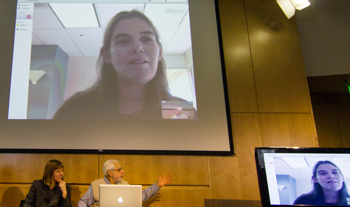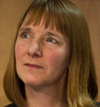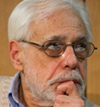| MOOCs and the Emerging Digital Classroom | |||
| Thursday, March 21,
2013 Abstract Moderator: David Thorburn is Professor of Literature at MIT and has been the director of the MIT Communications Forum since 1994. Video of MOOCs and the Emerging Digital Classroom is available. [this is an edited summary, and not a verbatim transcript] Photos by Greg Peverill-Conti Daphne Koller, co-founder of Coursera who joined the discussion remotely from her Stanford office, opened the Forum by referring to her company's 2011 launch as the start of "a revolution." Coursera is an online platform for MOOCs, or massively open online courses. Free and open to as many students as wish to enroll, MOOCs simulate the university classroom experience online. Using the web, MOOC students access videos of professors’ lectures and complete assignments, working towards a certificate. Often, they can communicate with other students using a discussion forum. MOOCs have attracted huge amounts of attention since the launch of Coursera and its competitor edX, a MOOC platform started by Harvard and MIT. Together, the two websites have inspired a public dialogue about the future of higher education and the role of the university in contemporary society. Coursera started in 2011 when a team at Stanford University decided to open three graduate-level classes in computer science to online learners. The Stanford organizers, of whom Koller was one, expected no more than few thousand students to enroll. Instead, they were flooded with 100,000 remote learners. At that moment, Koller and her collaborators realized they had hit on a potentially revolutionary idea. Today, Coursera has expanded to include more than 330 course offerings from various public and private universities, including Stanford. As of March 2013, more than 3 million students -- from countries all over the world -- have enrolled in Coursera classes. In addition to serving the population known as “lifelong learners” -- non-traditional students interested in taking a class outside a university for their personal edification -- Coursera also serves overlooked communities of students. Koller said that many of Coursera’s learners have been underserved by their local educational systems. Others have physical or learning disabilities that make it difficult for them to participate in traditional classrooms. For instance, according to Koller, several autistic students found Coursera's distance-learning format helpful. She also mentioned that a Coursera student suffering from cancer had reached out to her, saying that as she was too sick to leave her home regularly, Coursera's classes had become her "window to the outside world." Koller, who joined the discussion remotely, referred to Coursera’s teaching method as “video-based learning.” Students watch videos of professors’ lectures online. They can fast-forward, rewind, or re-watch as many times as they wish. According to Koller, the video format lets students browse lectures at their own pace, “allowing us to break away from the one-size-fits-all model of education” that characterizes the traditional classroom. Every week, Coursera students must complete a homework assignment to demonstrate that they’ve learned the material. Because the large number of students in Coursera classes would make traditional graders too costly and time-consuming, Coursera’s courses often use automated computer grading systems. Koller said that the immediate feedback provided by automated grading systems transformed homework into a process resembling a computer game. Students are “incentivized” to try to “beat the system” by resubmitting their work and achieving a higher grade. Some Coursera classes used a peer-grading format, which researchers also found to be highly effective. For a $40 fee, Coursera provides an identity-verified certificate to enrolled students -- ensuring that they are the ones completing their work in the class. Upon successful completion of the course, these credentialed students will receive a certificate of graduation that they can submit to potential employers, or anyone else who may be interested in their educational record. Coursera will also waive the credentialing fee for any student who demonstrates financial need. Koller concluded by discussing the demographics of Coursera’s learners. A third of Coursera’s students come from the United States, 30% reside in Europe, and the rest are from around the world -- many “in what the US State Department has called the developing world.” MOOCs provide an unprecedented opportunity to reach those populations, she said, transforming “education from a privilege of the few to a basic human right.”
Anant Agarwal, president of the MIT and Harvard-sponsored MOOC platform edX, began his presentation by asking the audience to call out the biggest innovations in transportation in the past 400 years. The audiences’ answers included planes, trains, automobiles and highways -- the inventions that connect today’s world. Next, Agarwal asked the audience to shout out any transformative inventions in education that postdated the printing press. After an audience member mentioned textbooks, the examples dried up. The import of this, Agarwal argued, is that access to educational technology is not the primary problem for today’s world; it is access to education, period. There are large parts of the world where people don’t have good access to education, he said. Even within the US, many students aren’t able to enroll in advanced courses. EdX was founded by Harvard and MIT to address these disparities. Each institution committed $30 million to the initiative with the mandate that it “rethink education from the ground up.” In addition to providing free and open courses, edX is an open-source platform. “We’re giving the code away for free,” said Agarwal. According to Agarwal, edX is or may be the “particle accelerator of learning.” The behavior of students on the platform is a unique source of insight into pedagogy. So its staff essentially conducts ongoing research and is able to refine and improve edX with unprecedented speed. Their findings may have important lessons for changing educations generally. One small example: most of the video on edX is accessed between midnight and 2 a.m. If that’s the period students prefer to learn, why do teachers hold class in the early mornings? The first class edX offered was an introduction to circuits and electronics taught regularly at MIT. Over 154,000 students enrolled. Of those, 26,349 tried the first problem set, 10,547 made it to the midterm, and 7,157 passed the final, graduating with a certificate from MITx. It’s impossible to overstate the significance of those numbers, said Agarwal. The initial number of students who enrolled—154,000 -- is larger than the total number of alumni who graduated from MIT its 150-year history. There is also a potential overlap between online and campus audiences, said Agarwal. Several of the students who enrolled in the edX circuits class were high schoolers who ended up being accepted to MIT, while many MIT students regularly used edX lectures for reference in on-campus work. From the circuits class, Agarwal and his team learned that online learning was efficient from an economic perspective. The edX course required no more staff resources than a 150-person lecture at MIT, while serving many more students.
I haven’t taught a MOOC, said Alison Bylerly, provost at Middlebury College and the president-elect of Lafayette College. But I can comment on the phenomenon from the perspective of an educator with an administrative background. Like many people in higher education, Bylerly had been giving a great deal of thought to what MOOCs mean for colleges and universities. Many of the debates over MOOCs had been summarized in publications like the New York Times and the Chronicle of Higher Education. The most extreme viewpoints, she said, present MOOCs as either the savior of the university or the destroyer of education as we know it. This drew appreciative laughs from the audience. She said she hoped to sketch out a middle ground. How can we account for the extraordinary interest in MOOCs? There’s been no bigger educational story than MOOCs in a long time. Furthermore, they open the ivory tower. Most people don’t have access to the elite higher education provided by institutions like MIT and Stanford. MOOCs present a graspable version of those fantasy institutions. For universities, MOOCs are an “inoculation” against technology getting the better of them. The Internet has brought enormous changes in the teaching and learning experiences offered to students. Universities want to feel as if they are ahead of the curve, and MOOCs provide a mechanism for doing so. What does it mean to talk about “the digital classroom?” Byerly asked. Why is that a metaphor for students’ experience in MOOCs? Why are we using spatial metaphors like “the classroom” to define MOOCs. Can such metaphors help us distinguish between MOOCs that are simply content delivery systems and those that build the intellectual communities we’ve come to associate with classrooms and universities? Finally, Byerly asked, what is the relationship between MOOCs and the rest of the university curriculum? Who controls the selection of MOOC courses, and what input does the faculty have? There are many issues that need to be sorted out, she said, both inside and outside the university. Questions and Answers
David Thorburn, Director of the Communications Forum and panel moderator, asked about the effect of MOOCs on smaller, local colleges. So far, innovations in MOOCs have been dominated by wealthy, elite institutions like MIT, Harvard, and Stanford, Thorburn observed. Can schools without brand-name attraction compete? Or will elite institutions create a monopoly system that will cause difficulty for smaller schools? Quality content is king, said Koller. Whether the transition is good or bad for all colleges, top-notch content will now be free and ubiquitous thanks to the Internet and MOOCs, and whatever institution is capable of providing the best content will survive. Koller said she didn’t think smaller institutions would go out of business, but accreditation was nevertheless “a lame answer” to the “value proposition” of an institution. Universities are turning students away at every level, said Agarwal. Online learning bridges the divide between the universities that have a little money and the ones that are rich. “Online learning is a rising tide that’s going to lift all boats.” Conveying content is better done through video and textbooks, and that might increasingly migrate online. At institutions of every level, professors should use face-to-face class time to help students process information. Interaction is what teaching should be all about. A lot will hinge on the structures by which content opportunities are disseminated, said Bylerly. Content is already available in so many different ways. With the Internet, for instance, a wealth of information is available to students outside the classroom. Colleges don't sell content, they sell the interaction—but what is the site of that interaction? Is it the Internet, or the physical classroom? Another factor that makes colleges unique is that institutions tailor what they do to the student population they serve. MOOCs address a much more diverse group of learners. If you have the ear of a government official, banker, or entrepreneur in Africa, what would you tell them about MOOCs? asked an audience member. What is your one-line pitch? Governments can help provide access to infrastructure, said Agarwal, and I’d urge leaders to make strides in improving wireless access. I’d tell entrepreneurs to look at existing infrastructure and think how to repurpose it. For instance, there are many unused post offices in Africa. Can they be turned into online community centers? I’m glad you brought up the government, said Bylerly. MOOCs should not give governments the excuse to privatize education -- something that was universally considered the purview of the government. Online courses do not absolve local governments from their duty to provide high quality education to students. MIT classes have a rigor known to students all over the world, said Chris Peterson, graduate student in MIT’s Comparative Media Studies program. EdX courses are undiluted, and students have to work hard to handle the MIT curriculum. Are there plans for a pipeline development program to build up students’ skills and get them to a point where they can jump in to an MIT class? Has edX thought about building out more entry-level classes to help students tackle MIT content? The MOOC content a university puts out depends on the institution, said Agarwal, noting that edX had a variety of partner institutions beyond MIT that might provide other types of courses. All edX courses are taught to the rigor of the courses on each University’s campus. That being said, there are more and more freshmen level courses being offered, and other universities may create more accessible "on ramp" courses. We have to build a pipeline and start early, he said, but at the same time, we don't want to water down university content. It is important to have a broader range of institutions represented in MOOC platforms, said Koller, so that we can teach students with broader range of abilities How can university librarians support MOOCs, asked an audience member. Anyone who is a purveyor of knowledge can play a central role in the development of online courses, said Agarwal. Copyright and fair use issues haven’t been fully articulated in MOOCs yet, and that’s a vital role for libraries. Libraries can also help instructors accumulate databases of various open source content, and provide that digitized content in various forms. This would require libraries to become more media-centric and savvy, but they’re increasingly moving in that direction anyway. Do you have any ideas for increasing course completion rates, asked an audience member, noting that it was fairly shocking to see more than 150,000 students enroll in a MOOC and only 7,000 graduate. First, we have to look at what those completion rates actually mean, said Agarwal. When you understand what it is, those numbers are actually pretty good. Many people enrolled in the edX course just to see what it was. If you count active learners as ones that clicked on a meaningful homework exercise, then the total is roughly 26,000, and the 7,000 students who finished the course comprise roughly 30% of that number. Furthermore, those 26,000 people did not pass a university admissions test. Anyone can participate in this class, whether or not their parents could afford to send them to an SAT prep school. That’s potentially revolutionary. Coursera has a 40-50% completion rate for most classes, said Koller. The percentage jumps to 75% for the students who pay to receive an identity-verified certificate. This proved to the Coursera team that it helped to have “skin in the game,” in the form of a financial investment. Completion rates are only part of the equation, though -- MOOCs are providing risk-free exploration. If students don’t know what they want to do, they can enroll in a MOOC and it doesn’t involve a huge amount of college tuition or a failure on their transcript, said Koller. I see a lot of potential in MOOCs, but I have some reservations, said Scot Osterweil, director of the MIT Education Arcade. My fear is that some local governments or institutions will see online education as an excuse to have less trained, less well-paid instructors. How can we as providers prevent that future from happening? I don't believe that will happen, said Agarwal. Before textbooks, teachers would memorize content and explain it students. And people had the reservations about textbooks, saying it would replace teachers. Instead, we have so many more teachers because they are all enabled. Online learning is the new textbook. It will enable a mushrooming of the industry, and a new generation and class of teachers. We are in for an exciting ride. MOOCs dramatize good teaching in a way that was previously invisible, said Bylerly. It helps instructors figure out how to up their game a little bit.
| |||




